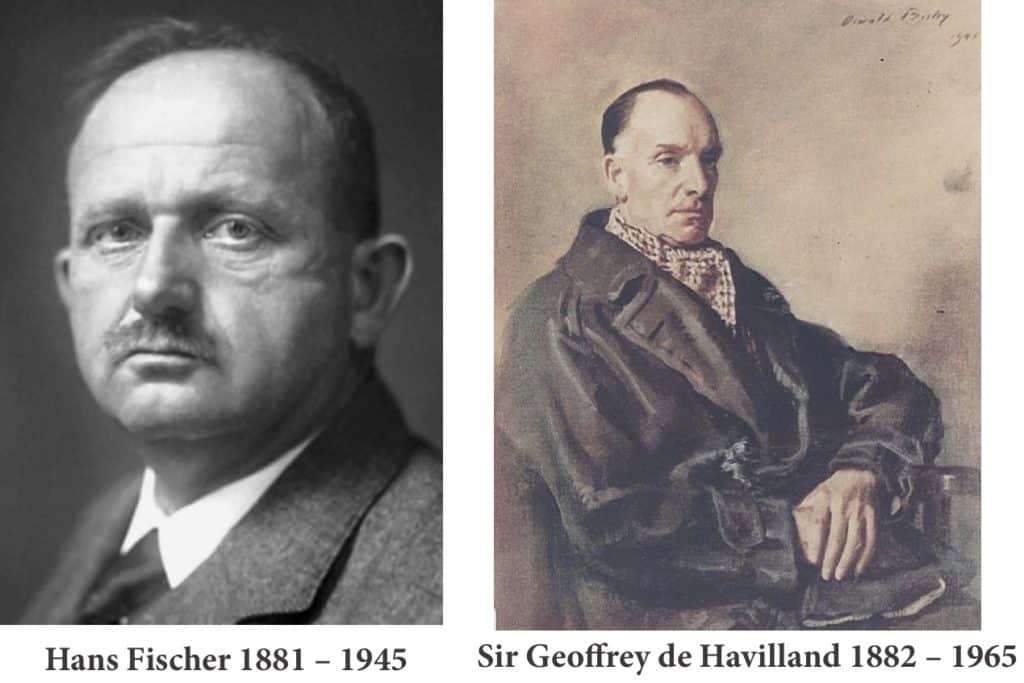
Hans Fischer was born on July 27, 1881, in Höchst, Germany. Exactly one year later, his birthday “twin,” Geoffrey de Havilland was born in Buckinghamshire, England. Though World War II was about 6 decades in the future, it would turn out, as their lives unfolded, that these two brilliant men would find themselves on opposite sides of that global conflict .
Fischer began his academic career in the study of chemistry at the Technical University in Munich in 1899, and by 1904 had received his Ph.D. while collaborating with the esteemed chemists Otto Diels, Heinrich Wieland, and Emil Fischer. During the years that followed, Hans continued to expand his expertise in organic chemistry and biochemistry. In 1921, he was appointed Professor of Organic Chemistry at the Technical University of Munich, a position he would hold for the rest of his life.
Meanwhile, Geoffrey de Havilland was studying engineering at the Crystal Palace School of Engineering in London. His fascination with the emerging field of aviation prompted him to teach himself how to fly and, in 1909, he joined the Royal Aircraft Factory at Farnborough where he designed and developed aircraft. His design of the B.E. 2 British reconnaissance aircraft that had proved effective in World War I brought him widespread acclaim, and in 1920, de Havilland founded the de Havilland Aircraft Company.
While de Havilland was experimenting with the structure of aircraft, Hans Fischer was exploring the structure of hemin, the complex organic molecule that is a vital component of hemoglobin. By splitting in half the molecule of bilirubin, a pigment related to hemin, he obtained a new acid in which a section of the hemin molecule was still intact. This made possible the artificial synthesis of hemin from simpler organic compounds whose structure was known. In 1929, Fischer not only determined the structure of hemin, but he also described how hemin aids in transporting oxygen in the blood–an achievement for which he was awarded the Nobel Prize in chemistry in 1930.
Four years after Fischer’s stellar achievement, Geoffrey de Havilland released his DH.88 Comet racer that won top honors in an air race from England to Australia in record-breaking time. De Havilland’s creative aircraft designs that won records in speed and distance had won him recognition as a foremost designer of aircraft.
During the 1930’s Fischer continued his work in organic chemistry, making significant discoveries about the structure of various porphyrins associated with hemin. Fischer also explored the structure of pyrrole from which the pigments in chlorophyll are derived. In 1941, he was appointed Director of the prestigious Kaiser Wilhelm Institute for Medical Research. At that time, World War II was in full flight and de Havilland was hard at work developing aircraft including the Mosquito, a fast versatile aircraft used for reconnaissance, bombing and night fighting. In 1944, Geoffrey de Havilland was knighted for his contributions to aviation. The following year, air raids destroyed Han Fischer’s laboratory, and he fell into a deep depression that ended in his suicide, just one month before Germany surrendered. After the war, Geoffrey de Havilland continued to run his company, but in 1960 he sold it to Hawker Siddeley and de Havilland retired from the aviation industry. He died on May 21, 1965 at the age of 82. Two fertile minds born one year apart and engaged in separate pursuits were connected only by their investigation of structure, yet they found themselves on different sides during World War II and had different endings.
